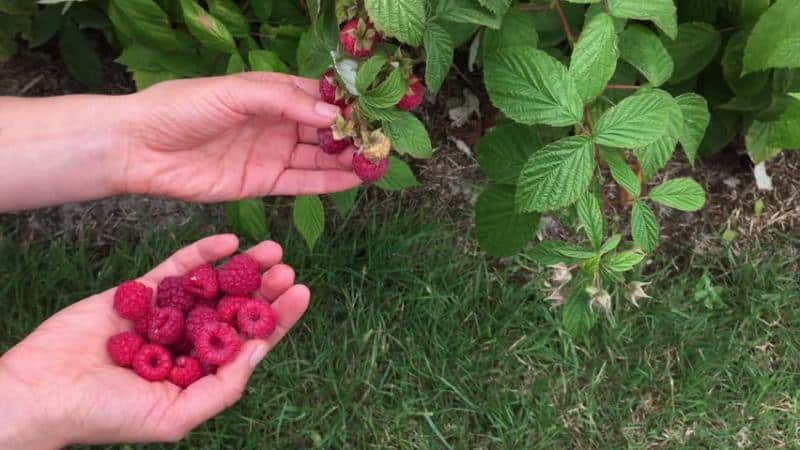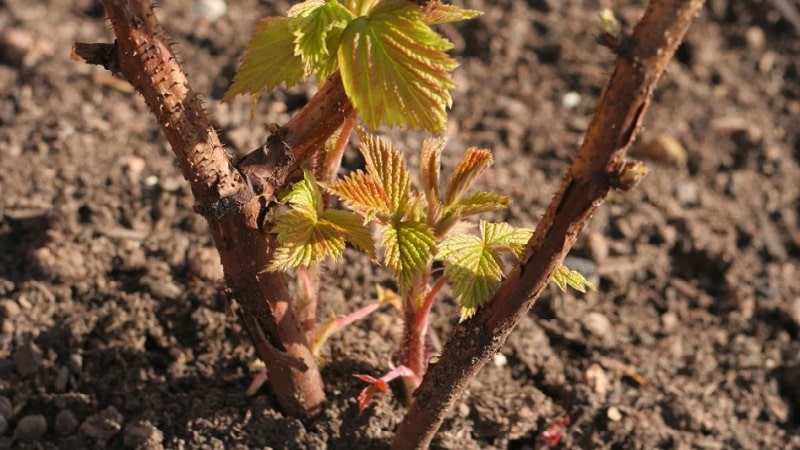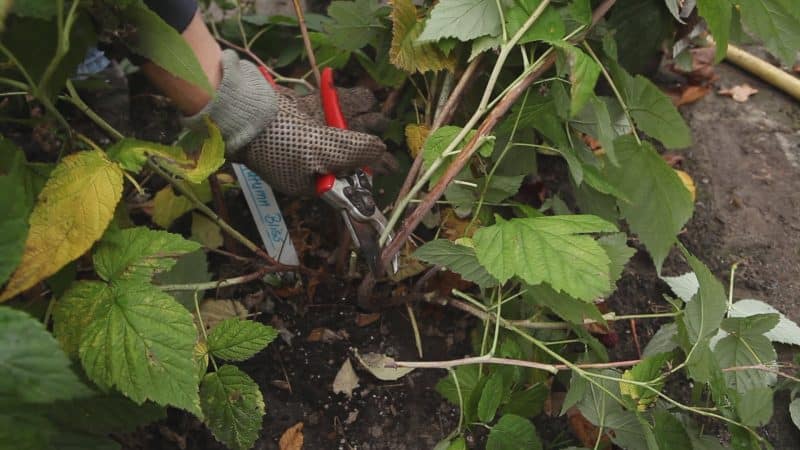Features of caring for raspberries in the Moscow region: how to properly prepare for winter
To obtain a rich harvest of raspberries, plants are prepared for winter frosts in the fall: they are fed, watered, pruned and treated against pests. If agricultural cultivation techniques are followed in the Moscow region, up to 3 kg of berries per bush are obtained. Let's look at how to properly prepare crops for cold weather and in what time frame.
Agricultural technology for growing raspberries in the Moscow region
Wild raspberries grow wildly in clearings and forest edges; they love open but sheltered places from the wind. The same conditions are created for domestic shrubs. The ridges are positioned from north to south so that they are illuminated by the sun all day without being shaded by trees.

Planting raspberries in the Moscow region and care behind her are simple. The soil should be neutral or slightly acidic. Raspberries love well-fertilized soil. Tomatoes, strawberries and potatoes are not suitable as predecessors: they have common diseases.
The shoots are planted in holes or furrows into which fertilizers have been applied. The plants are tied to a wire stretched between the posts, or a support is placed for each bush.
Care consists of:
- treating plants against pests;
- mulching the soil;
- weeding as necessary;
- thinning shoots to 6 pieces per 1 linear meter;
- abundant watering;
- applying potassium-phosphorus fertilizers during flowering;
- autumn pruning;
- preparation in winter.
The harvest is harvested once every 3 days. The bushes bear fruit in the 2nd year of life.
When to plant

When is it better to plant raspberries in the Moscow region: in spring or autumn? In mid-latitudes there is a high risk of severe frosts in winter, so planting in spring is preferable: from early March to mid-April. If this is not possible, the procedure is postponed to the end of September - mid-October. During this time, the shoots will have time to take root in the ground. Summer is also allowed landing plants in containers with a closed root system.
When to replant raspberries in outskirts of Moscow? This is done in the fall, when there are many shoots of the current year on the bushes. Optimal period: from late August to mid-September. The procedure is especially important for plants that are more than 10 years old. In this case, the old rhizome is removed, and the young shoots are transplanted to another place.
How to prepare raspberries for winter in the Moscow region
For the first time, raspberries are pruned in June - July when the bushes reach 80 cm in height. The second time this is done in the fall.
Autumn pruning
To increase the yield next season, berry beds are formed and fruit-bearing shoots are removed. The latter continue to extract useful substances from the soil, their roots grow, capturing new areas of the soil. If the branches were not removed immediately after harvest, they are pruned in the fall.
Important! The bushes are formed so that all branches have access to light, and the berries grow large and sweet.
Proper formation of the berry bush prevents the development of diseases.
When to prune
It is better to remove fruit-bearing shoots immediately after harvesting. Without them, young branches will develop more intensively. The remaining work is carried out before the onset of frost.
Two-year-old raspberries are pruned from late August to October, remontant ones - in late autumn.
How to trim

Use sharp pruning shears.It is first disinfected with alcohol, cologne, and alcohol wipes, so as not to introduce spores of fungal diseases and viruses to healthy plants.
A solution of copper sulfate (2 tablespoons per 0.5 liters of water) is also used for disinfection, but the metal is not allowed to remain in contact with the reactive medium for a long time.
Instructions and cutting methods
Pruning an ordinary two-year-old raspberry consists of several operations:
- All fruit-bearing shoots are removed if this was not done immediately after picking the berries.
- Weak, small and green immature branches are also removed: they are unlikely to survive the winter, they will freeze and rot in the spring.
- The raspberries are thinned out, leaving 60 cm between the bushes.
- The branches inside the bushes that thicken them are removed, leaving 5–8 shoots.
- When planting with trellises, leave 10–15 cm between shoots.
- The tops of the tallest plants are cut so that their length is 120–150 cm.
Remontant raspberries are pruned in 2 different ways:
- To obtain one harvest next year, all shoots are pruned at the root in late autumn.
- To harvest two harvests, only fruit-bearing branches are removed, as in conventional varieties.
Raspberries produce berries both on last year's shoots (in summer) and on new shoots (in autumn).
Top dressing
After pruning the bushes, fertilizers are applied: the plants greatly deplete the soil over the summer, and many useful substances are carried away with the cut shoots. If you don’t feed raspberries, every year the harvest will become poorer and the berries smaller.
The best fertilizer is rotted manure. It is applied at about 2 kg per 1 m2 of soil, mixed with 3–5 g of phosphorus and potassium.
If only minerals are used, then superphosphate will require 60 g, and potassium salt - 30–40 g per 1 m2.
In order for the fertilizing to reach the root system, the products are scattered along a groove dug to a depth of 10–15 cm, at a distance of 20–30 cm from the bush.
Soil treatment
Simultaneously with the fertilizer, the soil is dug up to a depth of no more than 10–12 cm, since the roots of raspberries are located close to the surface.
Before frost, plants are watered abundantly (2 buckets per bush). Soil saturated with water prevents roots from freezing. In frosts and conditions of low humidity, plants become dehydrated, and pre-winter moisture prevents them from drying out.
Pest and disease control
Remove diseased, dried and broken branches - hotbeds of dangerous diseases and habitats for harmful insects. The soil is carefully dug up.
All remaining leaves removed from the shoots without damaging the buds. To do this, carefully move your hand along the trunk from bottom to top.
Important! To avoid damaging your hands, be sure to wear gloves.
All plant residues are removed from the raspberry patch and burned so as not to re-infect the area. With the onset of light frosts, the crop is sprayed with a 2% solution of Bordeaux mixture.
Mulching and bending down shoots
Mulch the soil under raspberries throughout the summer, since loosening can easily damage the surface roots. In winter, the old mulch is removed along with the pests that have settled under it.
In severe frosts, when there is no snow, they follow the rules for caring for raspberries at a dacha in the Moscow region.
To protect plant roots, cover the soil with:
- straw;
- peat;
- humus;
- pine needles.
These materials not only protect raspberries from freezing, but also fertilize the soil. It is better to use straw together with manure or humus. Needles kill pathogenic bacteria.
When all preparations for winter are completed, one-year-old shoots are bent to the ground so that the snow cover protects them from severe frosts.
This is done in one of the following ways:
- the top of the branch is tied to the base of the adjacent one;
- shoots are bent to the ground and secured with a bracket;
- weave the branches together and press them to the ground.
If the branches bend poorly, the procedure is carried out in stages: on the first day they bend as much as possible, and on subsequent days - even lower.
Attention! The shoots are not lowered below 40 cm to the soil level: in a snowy spring they will begin to rot.
Bend down the branches before they become brittle, that is, before frost sets in.
Covering for the winter
The best shelter for raspberries is snow. It will cover the shoots bent to the ground and protect them from freezing. If precipitation falls late, severe frosts will damage unprotected plants. For such cases, polyethylene and spunbond are used.
Frames (bent metal rods) are installed above the stems, onto which the material is stretched in several layers.
Nuances of caring for different types
The care and cultivation of remontant, ordinary biennial and tree raspberries in the Moscow region are in many ways similar.
There are some features of pruning and covering:
- if next year they plan to get one harvest of remontant raspberries, in the fall all its shoots are removed at the root (there is no need to bend the stems to the ground);
- Fruit-bearing shoots are removed from the raspberry tree and dug in for the winter.
What happens if you don't prepare raspberries for winter?
If the winter is warm and snowy, the raspberry tree will not freeze even without bending down the branches and shelter, and next season it will produce a rich harvest. If the winter is frosty and with little snow, there is a high risk of losing berries next year.
Pruning and fertilizing will benefit the plants and increase their productivity in any weather.
Conclusion
In the fall, before frost, it is important for plants to return the nutrients that were taken from them with the harvest. To do this, mineral and organic fertilizers are applied. The bushes are pruned and thinned, protected from severe frosts, and disinfected with Bordeaux mixture. The soil is dug up, moistened and mulched.
Beautifully written, but at a gallop... What, you don’t need to feed raspberries with magnesium and a lot of other things in the fall? We got amateur copywriters. . However, it is unlikely that the author will allow this to be published